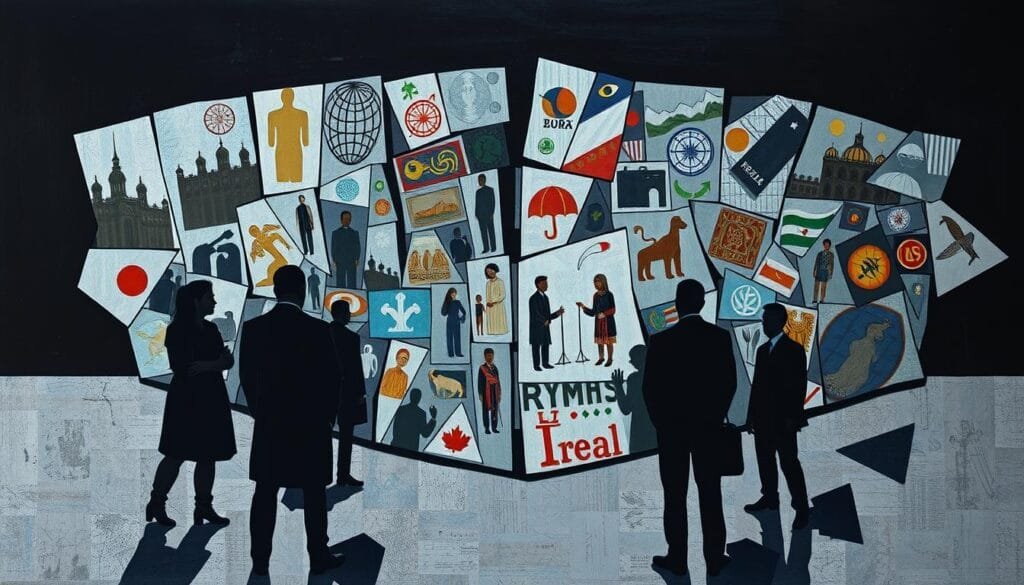How does fear shape interactions in diverse cultures? How does it affect our ability to be inclusive?
Fear has a big influence on how we act and see things in multicultural places. Our world has many cultural groups today. This makes it important to be aware and sensitive about different cultures.
Fear often controls how we respond to cultures we’re not familiar with. It makes it hard to communicate well and understand each other. This is even more true in places with lots of refugees and migrants. They usually get low-paying jobs. This leads to money problems and mental health issues.
Let’s talk about how fear affects our cultural sensitivity. We’ll discuss the mental effects and ways to get past these challenges. Our goal is to create a society that’s more welcoming and understanding.
Key Takeaways
- Fear greatly affects our dealings in multicultural spaces, causing misunderstandings.
- Income differences among refugees and migrants can make fear and alienation worse.
- Western mental health approaches might not fit with non-Western cultures, which is a challenge.
- It’s key to know about cultures to include everyone and manage fear well.
- Using empathy and open talking can help overcome cultural differences and fear’s effects.
- Inclusive and diverse places lead to better choices and creativity, showing the importance of cultural sensitivity.
The Intersection of Fear and Cultural Sensitivity
Exploring how fear and cultural sensitivity interact is complex. It changes how we act in multicultural environments. This discussion looks at how fear affects human behavior in these settings. It also examines cultural sensitivity and fear’s role in our interactions.
Understanding Cultural Sensitivity
Cultural awareness and respect form the core of cultural sensitivity. The ACA Code of Ethics 2014 highlights the need for cultural competence in counselors. They should understand diverse groups well. This path requires constant self-exploration and willingness to learn. For example, including a client’s family in therapy can make counseling more effective. This is especially true in cultures that value family input.
The Role of Fear in Human Behavior
Fear often comes from not knowing. It can greatly block cultural sensitivity. Studies show that negative news is more common than positive news. This negativity grabs more attention, especially fearful faces. These invoke strong reactions in brain areas linked to fear, like the amygdala. So, understanding fear helps tackle biases in cross-cultural interactions.
Challenges in Multicultural Interactions
Misunderstandings pose big challenges in multicultural settings. For instance, there’s a tendency to think negatively in international business studies. This shows in a focus on negative over positive cultures. Counselors need to break down these biases with better cultural awareness and skills. Below are some key facts and their effects on multicultural dealings:
| Factor | Impact |
|---|---|
| Negative Phenomena in Business Studies | 4 times higher than positive (Margolis & Walsh, 2003) |
| Attention to Negative Stimuli | More reactive within 200 ms (Huanga & Luoa, 2006) |
| Higher Negativity Bias in Youth | Neutral events perceived more negatively (Marusak et al., 2017) |
To tackle these challenges, we need an environment where understanding and empathy are key. Being inclusive and open helps. This way, we reduce fear’s impact on cultural sensitivity in diverse settings.
The Psychological Impact of Fear on Cultural Sensitivity
Understanding how fear affects us is key to being culturally sensitive. Fear can create anxiety, changing how we act with different cultures. If we understand this and use Cognitive Behavioral Therapy (CBT), we can improve our cultural sensitivity.
Fear and Its Effect on Anxiety
Fear often leads to anxiety. This can change how we see and interact with other cultures. For example, Asian individuals might show their anxiety differently than others do.
How Cognitive Behavioral Therapy Addresses Fear
CBT works well in different cultures. It helps by changing how we think and react to fear. This makes us better at dealing with cultures different from our own.
Case Studies and Real-Life Scenarios
Many cases show CBT helps with cultural issues. LGBTQIA+ adults, for instance, face more emotional challenges. CBT can help them and others be more accepting and inclusive.
Here’s an informative table summarizing the mental health conditions with cultural nuances:
| Disorder | Lifetime Prevalence | Cultural Factors |
|---|---|---|
| Schizophrenia | 1% | Diverse symptom presentations across cultures |
| Bipolar Disorder | 0.3% to 1.5% | Varies significantly across regions |
| Panic Disorder | 0.4% to 2.9% | Prevalence affected by cultural context |
CBT helps diverse people interact better. For example, transgender people, who often face mental health challenges, can use CBT to improve. This leads to stronger cultural connections.
Organizational Culture and the Influence of Fear
Understanding how organizational culture works is crucial. The influence of leaders and creating welcoming work environments are key for performance and employee health. Fear often plays a big role in these areas.

The Role of Leadership
Leaders have a big impact on company culture. Using fear to control people works for a while but kills creativity and growth. Good leaders promote inclusivity and open talks, creating a space where everyone feels free to share ideas.
This approach leads to innovative workplaces. They emerge from diverse thoughts and feelings. This shows why having an inclusive work environment is so important.
Creating an Open and Inclusive Environment
Building an open and welcoming environment is crucial for a positive company culture. Firms that focus on making employees feel safe see less staff leaving. They also report better job performance and happiness.
Such workplaces drive involvement and spur innovation. They lead in the market too. About 70% of workers worry about changes at work. This shows the importance of clear leadership to lessen fear and resistance.
Impact of Fear-Based Leadership Styles
Fear-based leadership is harmful. A survey from 2019 showed that 61% of workers felt too stressed. This stress led to tiredness and a feeling of losing grip. Fear stops taking chances and narrows thinking, making outcomes seem bleak.
Bad leadership methods like scaring people, being passive-aggressive, or too controlling create a bad work atmosphere. This hurts employee development and lowers job satisfaction. Firms that encourage freedom and growth over fear do much better.
| Aspect | Inclusive Leadership | Fear-Based Leadership |
|---|---|---|
| Employee Turnover | Reduced (up to 50%) | Increased |
| Employee Engagement | Higher | Lower |
| Innovation | Enhanced | Stifled |
| Performance | Increased (up to 25%) | Decreased |
| Psychological Safety | Prioritized | Neglected |
How is Being Scared Affects Cultural Sensitivity
The impact of fear on cultural sensitivity is huge. It changes how we think and how we connect with others from different cultures. When fear increases, our ability to understand and communicate in multicultural environments decreases.

Anxiety disorders look different across the globe due to cultural differences. The 1980s Epidemiological Catchment Area studies showed how culture impacts anxiety recognition. The Composite International Diagnostic Interview (CIDI) used consistent criteria for international research. It found big cultural differences in diagnosing anxiety.
It’s important to see how fear and cultural understanding intersect in health diagnoses. In places like the US and Europe, awareness of mental health issues is higher. There, studies show more agreement in the rates of anxiety disorders. On the other hand, a survey in China found many anxiety disorders didn’t fit well with Western diagnostic criteria. Nearly 60% were labeled as Not Otherwise Specified, showing a cultural gap.
| Region | Awareness Level | Prevalence of Anxiety Disorders |
|---|---|---|
| United States | High | Convergent |
| Europe | High | Convergent |
| China | Moderate | Divergent |
Diagnostic rates change with local cultures’ reactions to survey questions. Societies with more knowledge of mental health issues see rates of anxiety that align more closely. For example, a study found that fear made some union members think about quitting their jobs. This shows that fear can deeply affect workplace culture. Research also suggests that using fear in a controlled way can keep fear present in organizations.
To improve cultural sensitivity, we must address these fears. According to W. Edwards Deming, fear goes against productive business practices. Terrorist attacks, while infrequent, get a lot of media attention. This increases public fear and can change how people see the world. It can even lead to support for controversial policies, as seen after events like 9/11. The long-term effects of this fear culture include more cases of anxiety, depression, and insomnia for those constantly exposed to media coverage of violence and terrorism.
Strategies for Overcoming Fear in Multicultural Contexts
To tackle fear in multicultural settings, we need planned strategies. These strategies should increase empathy and understanding. They should encourage talking openly and make safe spaces for sharing thoughts. This way, we can fight biases and fears, leading to better cultural connections.

Promoting Empathy and Understanding
Building empathy and understanding is key in multicultural interactions. Studies reveal that traveling or joining cultural events greatly boosts cultural empathy. After such activities, 60% of people feel more empathetic. Sharing stories, traditions, and customs from different cultures helps us appreciate diversity more. Listening well and trying to understand others can improve communication in diverse groups by 50%.
Encouraging Open Communication
To better communication, we need to encourage dialogue among diverse groups. Conflict resolution that includes various cultural viewpoints reduces misunderstandings by 40%. Organizations that value diversity training see a 35% increase in employee happiness and loyalty. This shows the importance of avoiding biased communication. Clear and respectful ways of talking can lower cross-cultural misunderstandings by half. Involving people in cultural and employee groups boosts teamwork by 70%.
- Travel and Participation: Taking part in cultural immersion or events.
- Active Listening: Trying to see different viewpoints.
- Conflict Resolution: Forming committees that include everyone for solving disputes.
- Diversity Training: Offering training to reduce prejudice.
- Respective Communication: Using clear rules for talking.
Attending cultural sensitivity workshops can improve how a team works together by 40%. Through these methods, we can diminish fear, build empathy, and improve talks. This creates a welcoming space for everyone.
Building Resilient and Inclusive Communities
Building resilient communities means we celebrate diversity and push for inclusion and cultural understanding. In our connected world, it’s key to have places where everyone feels safe and valued. This lets everyone thrive.
Importance of Diversity and Inclusion
Diversity touches many aspects of our communities. It includes race, culture, religion, and more. Unfortunately, ethnic minority children often face more suspensions and expulsions. This shows we need a deeper understanding of various cultures and beliefs.
We can emphasize diversity by bringing diverse educational content into our schools. Adding international celebrations and field trips helps too. This way, everyone learns more about different cultures.
Practices like gratitude walls can boost students’ confidence and positivity. These efforts make our communities stronger and more understanding.
Steps to Foster Community Support
A strong sense of belonging can raise how active people are in their communities. After divisive events, safety concerns can grow. But if people feel secure, their participation can jump by 40%. Diverse volunteer groups also see more people joining when the environment is welcoming.
Working together with local groups is a smart move. Schools, businesses, and nonprofits can all help. It’s also important to talk over tough topics respectfully. Most volunteers want to engage in these conversations.
Developing Cultural Competence
Cultural competence is crucial for strong, inclusive communities. It’s about understanding and valuing cultural differences. This understanding helps communities be more resilient. Resilience grows from safe and supportive relationships.
Schools can help by using diverse learning materials and celebrating various cultures. It’s also good to stress the importance of accepting setbacks as learning opportunities. Activities like yoga can boost mental health and wellbeing too.
Using resources that promote cultural understanding is important. For insights on cultural sensitivity in disaster help, especially for kids, visit this link.
By encouraging inclusion and resilience, we build a society where everyone is valued. This makes us all better equipped to face challenges together.
Practical Tips for Cultivating Cultural Sensitivity
Becoming culturally sensitive is key in today’s global society. Here, we share tips to help you grow personally and professionally. These tips enhance cultural understanding.
Personal Growth and Development
Self-growth is crucial for cultural sensitivity. It starts with knowing your own cultural biases. Diving into different cultural activities, like festivals or learning languages, opens up new viewpoints. The National Center for Cultural Competence tells us to appreciate how cultures are both similar and different.
We must keep learning. Dr. Ibram Kendi outlines a journey from staying comfortable to advocating for racial allyship. Making friends from different cultures allows for important conversations. These talks can turn awareness into real understanding.
Professional Training and Education
Professional improvement also matters for cultural sensitivity at work. Training gives employees skills to respect cultural differences. This leads to a better workplace atmosphere.
Trainings teach about Cultural Competence Continuum Model. It has six stages, from denying cultural differences to fully embracing them. This model helps people and businesses grow culturally.
Talking openly about systemic racism and cultural diversity is crucial. Dr. Page suggests discussing traditions and religions to foster respect. Such discussions in the workplace encourage an inclusive environment.
Using these tips in both personal and work life is essential. They help us grow and build better professional relationships. Embracing diversity brings everyone closer.
Conclusion
Understanding the link between fear and cultural sensitivity is key in both personal and organizational areas. Mental health issues like anxiety show different trends in various racial groups. For instance, White Americans see more social anxiety disorder at 12.6%, while African Americans have more PTSD cases at 8.6%.
Cultural sensitivity gets more complicated when we look at unique cultural beliefs. For example, Cambodians think anxiety comes from “inner wind” blockages. In contrast, Western cultures feel anxiety as fear, but Eastern ones might show it through body signs. This shows why understanding culture is vital in healthcare.
To deal with fear in diverse communities, we need key steps like increasing empathy, boosting open talks, and being more inclusive. Organizations must lead in a way that supports a welcoming space. At the same time, people should focus on growing personally and learning more about cultural awareness. By doing these things, we can all get better at working together in a global society.
FAQ
What is cultural sensitivity?
Cultural sensitivity means deeply understanding and respecting other cultures. It’s about knowing and valuing cultural differences. This promotes inclusion and empathy in diverse places.
How does fear impact cultural sensitivity?
Fear comes from not knowing and can block cultural awareness. It leads to actions that protect what feels safe. This can cause issues and conflicts when cultures mix.
How does anxiety affect our interactions in multicultural settings?
Anxiety comes from fear, changing how we see and act. It makes us less sensitive and empathetic. This leads to misunderstandings and possible conflicts in diverse interactions.
Can Cognitive Behavioral Therapy (CBT) help with fear-related anxiety in multicultural contexts?
Yes, CBT works well for anxiety caused by fear. It teaches people to handle their fears better. This improves how they connect in multicultural spaces and increases cultural sensitivity.
How does leadership influence organizational culture regarding cultural sensitivity?
Leadership is key in creating an organizational culture. Leaders who encourage openness and inclusion make a workplace that’s creative, dynamic, and respects different cultures. But, leadership based on fear can make a workplace that’s closed off and stressful.
What are some strategies for overcoming fear in multicultural contexts?
To overcome fear, use planned strategies. Encourage empathy and understanding. Push for open talks, and make safe places for sharing. These steps help deal with and lessen biases, making cultural interactions healthier.
Why is it important to build resilient and inclusive communities?
Making resilient and welcoming communities means accepting diversity and promoting inclusion. Knowing and appreciating cultural differences is vital. It makes communities stronger against dividing fears.
What are some practical tips for cultivating cultural sensitivity?
Tips for growing cultural sensitivity include learning continuously. Involve yourself in cultural experiences. Also, get formal training in understanding different cultures. These steps help people and groups grasp the subtleties and complexities of cultures.
